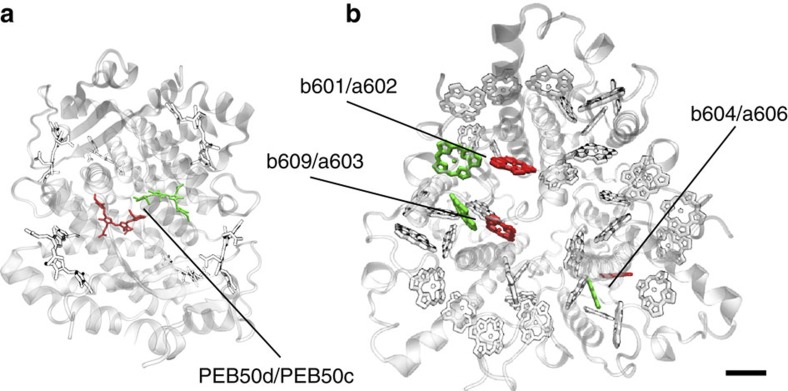Figure 1. Prototype dimers.
(a,b) Cryptophyte antennae phycoerythrin 545 (PE545) and LHCII present in higher plants have pairs of pigments whose electronic and vibrational parameters fall in the regime of our vibration-assisted transport model. (a) Representation of the pigments and protein environment of a PE545 complex of Rhodomonas CS24 (Protein Data Bank ID code 1XG0, ref. 32). The central PEB dimer pigments PEB50c and PEB50d are highlighted in red and green, respectively. For this PEB50 dimer, there is an uncertainty in the value of the energy gap32,33. We take parameters from refs 32, 33 such that Δε=1,042 cm−1 and V=92 cm−1, so ΔE=1,058.2 cm−1 being quasi-resonant with an intramolecular mode of frequency ωvib=1,111 cm−1. The strength of linear coupling to this mode is g=ωvib(0.0578)1/2=267.1 cm−1. (b) Representation of the LHCII antennae of Spinacia oleracea (Protein Data Bank ID code 1RWT, ref. 34). Several pairs of close Chlb-Chla (red-green) chlorophylls satisfy the conditions of our model. In particular, we consider the Chlb601-Chla602 pair for which Δε=661 cm−1 and V=−47.1 cm−1, resulting in ΔE=667.7 cm−1 (ref. 66). An intramolecular vibrational mode of frequency ωvib=742.0 cm−1 is close to this energy gap and each chromophore couples to this mode with strength g=ωvib(0.03942)1/2=147.3 cm−1 as obtained from (ref. 40). Scale bar: 1 nm.

